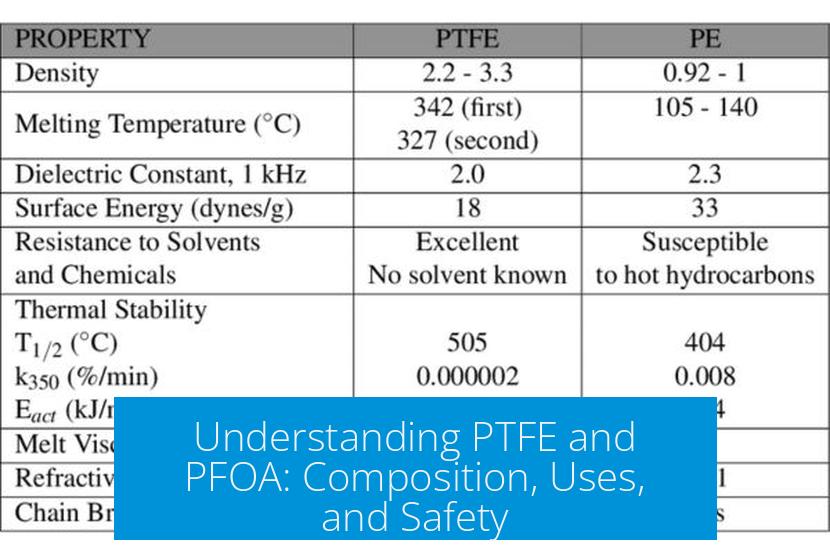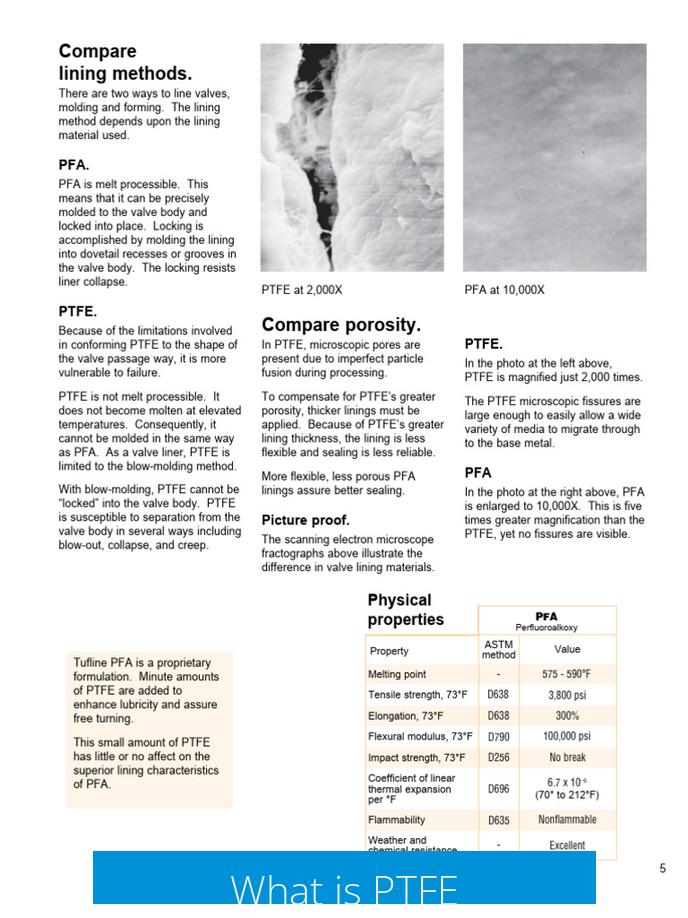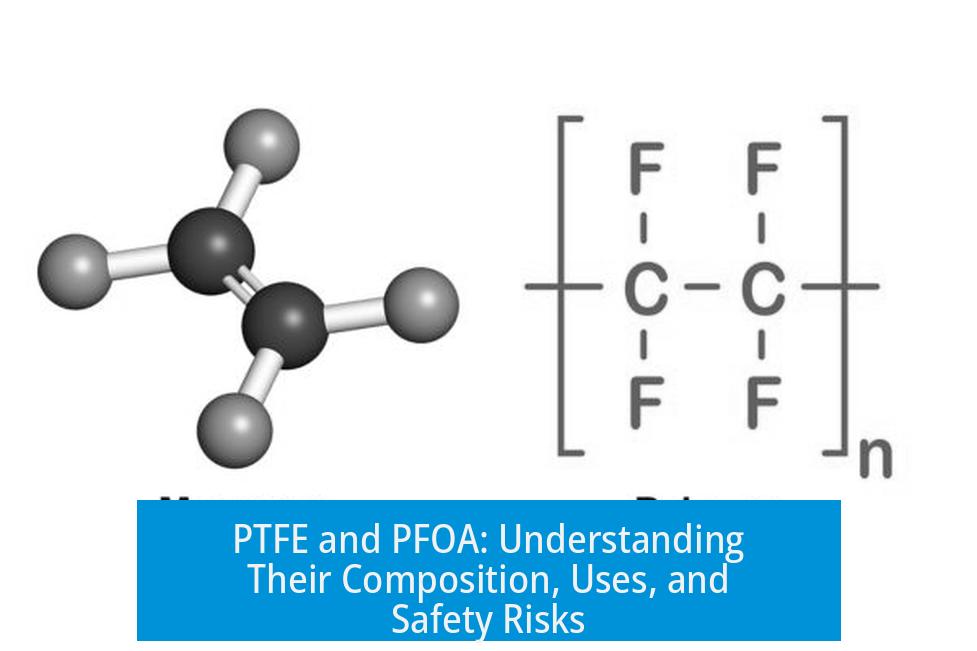Understanding PTFE and PFOA: Composition, Uses, and Safety

Polytetrafluoroethylene (PTFE) and perfluorooctanoic acid (PFOA) are distinct chemical substances with different roles and health profiles; PTFE is a stable, non-toxic polymer widely used for its non-stick properties, while PFOA is a fluorinated surfactant once used in PTFE manufacturing that poses toxicological concerns.
What is PTFE?

PTFE, often known by the brand name Teflon, is a synthetic polymer valued for its chemical stability and non-reactivity. It does not chemically interact with most substances, a property that makes PTFE an excellent non-stick coating in cookware and a reliable material in laboratories where resistance to organic solvents, strong acids, and bases is required.
- Composed of carbon and fluorine atoms forming a highly stable polymer chain
- Exhibits extreme hydrophobicity, preventing absorption into biological tissues
- Non-toxic in its intact form and does not bioaccumulate in the human body
PTFE retains its structural integrity up to about 350°C. Above this temperature, it can begin degrading and producing harmful decomposition products. Such degradation may release toxic fumes, so thermal limits are critical for safe use, particularly in cookware applications.
Role and Risks of PFOA
PFOA belongs to the broader group of chemicals known as per- and polyfluoroalkyl substances (PFAS). It functions as a surfactant to stabilize PTFE particles in aqueous suspensions for industrial processing because PTFE itself does not melt but decomposes under heat. This surfactant property allows manufacturers to spray-coat or otherwise shape PTFE coatings.
- PFOA interacts readily with water, increasing the potential for exposure and biological uptake
- Classified as an endocrine disruptor and suspected carcinogen in high concentrations
- Previously used in manufacturing processes but not a monomer for PTFE polymerization
- Trace residues may persist in some PTFE products, but levels are typically very low
Due to its environmental persistence and potential health hazards, the use of PFOA in producing PTFE has been phased out in many regions. However, consumer concerns linger regarding residual PFOA in older or uncertified PTFE cookware.
PFAS: The Broader Chemical Family
PFAS encompasses hundreds of synthetic chemicals characterized by carbon-fluorine bonds that resist degradation. These compounds persist in the environment for centuries and can accumulate in living organisms.
| Compound | Use | Health Concern |
|---|---|---|
| PFOA | PTFE surfactant | Potential endocrine disruptor, carcinogen |
| PFOS | Firefighting foams, stain repellents | Health effects similar to PFOA |
| GenX | Replacement chemical for PFOA | Under investigation for toxicity |
Regulatory bodies continue evaluating PFAS-related risks, with some jurisdictions proposing stricter controls or complete bans due to bioaccumulation and associations with cancers, immune effects, and hormonal disruption. Still, there is no universally accepted safety threshold for PFAS in foods or consumer products.
Recommendations for Use and Alternatives
Users of PTFE-coated products should avoid overheating cookware beyond recommended temperatures to prevent material breakdown and toxic emissions. If the coating chips or peels, ingestion should be avoided due to potential exposure to degraded products or residual chemicals.
- Prefer ceramic or cast-iron cookware for non-stick alternatives without fluorinated compounds
- Avoid products with PFAS where possible to reduce long-term exposure
- Be cautious with older PTFE cookware that may contain residual PFOA
Some voices in the scientific and consumer community advocate eliminating fluorinated compounds from food-contact materials due to their persistence and uncertain health effects.
Additional Considerations
There is occasional confusion about PFOA’s role in PTFE production. It is not a polymer building block but rather an emulsifying agent facilitating PTFE suspension in water. Additionally, concerns around microplastics relate more to physical effects, such as particle inhalation, rather than chemical toxicity directly linked to PTFE itself.
Key Takeaways
- PTFE is a stable, non-toxic polymer used primarily for its chemical inertness and non-stick properties.
- PFOA is a fluorinated surfactant formerly used in PTFE manufacturing; it is linked to health risks and environmental persistence.
- Cooking with PTFE is considered safe if temperatures remain below 350°C to prevent release of toxic degradation products.
- PFAS chemicals broadly pose environmental and health concerns, leading to increasing regulatory scrutiny globally.
- Alternatives such as ceramic, cast iron, or high-grade stainless steel cookware avoid PFAS-related issues.
For further in-depth discussion on PTFE, PFOA, and alternatives, resources include detailed videos and scientific reviews of PFAS chemicals available from trusted scientific channels.
What is PTFE and why is it used in cookware?
PTFE, also known as Teflon, is a non-stick material. It is chemically stable and does not react with food or most chemicals. This makes it useful for cookware and industrial uses that need resistance to acids and bases.
Is PTFE safe to use for cooking?
PTFE itself is non-toxic and not absorbed by the body. However, if heated above 350°C, it can break down and release toxic substances. Normal cooking temperatures usually do not reach this level.
What is PFOA and what role does it play with PTFE?
PFOA is a fluorinated surfactant used during PTFE processing. It helps create stable suspensions of PTFE particles in water for manufacturing methods like spray-coating. PFOA is not part of PTFE’s structure.
Are there health risks linked to PFOA in cookware?
PFOA can be harmful in high amounts and is considered an endocrine disruptor and potential carcinogen. Trace amounts might remain in cookware but are typically very low and unlikely to pose significant risk.
What alternatives exist to PTFE and PFOA in cookware?
Safer choices include ceramic, cast iron, and stainless steel cookware. These avoid fluorinated compounds and their potential health concerns. Avoid using cookware if the coating is peeling or damaged.





Leave a Comment